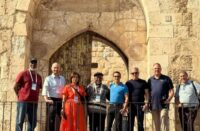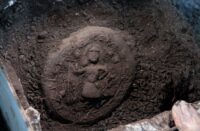
Originally published in Breaking Israel News
“And the LORD called unto Moses, and spoke unto him out of the tent of meeting, saying…” (Leviticus 1:1)
Advanced technology has allowed a rare and ancient Hebrew scroll, found over 40 years ago in the Dead Sea region, to be read despite its charred state, the Israel Antiquities Authority (IAA) announced. The scroll, found in a Holy Ark in an Ein Gedi synagogue, had been burned about 1,500 years ago.
The discovery was presented Monday at a press conference in Jerusalem, attended by Minister of Culture and Sports Miri Regev and Israel Antiquities Authority Director Israel Hasson.
The parchment scroll was discovered in 1970, during excavations of the synagogue done by the late Dr. Dan Barag and Dr. Sefi Porath and their team. At the time, its burnt state prevented it from being deciphered or preserved.

Now, however, the IAA’s Lunder Family Dead Sea Scrolls Conservation Center was able to decipher the text contained within the scroll. Using a MicroCT scanner offered by Merkel Technologies Company, Ltd., high-resolution 3D scans were taken of the scroll, along with several other items.
The IAA then sent the results to Professor Brent Seales of the University of Kentucky who developed a digital imaging software which allows to virtually unroll the scroll and visualize the text. The entire process took over a year, but in the end, the first eight verses of the book of Leviticus were identified within the charred scroll.
“The Lord summoned Moses and spoke to him from the tent of meeting, saying: Speak to the people of Israel and say to them: When any of you bring an offering of livestock to the Lord, you shall bring your offering from the herd or from the flock. If the offering is a burnt-offering from the herd, you shall offer a male without blemish; you shall bring it to the entrance of the tent of meeting, for acceptance in your behalf before the Lord. You shall lay your hand on the head of the burnt-offering, and it shall be acceptable in your behalf as atonement for you. The bull shall be slaughtered before the Lord; and Aaron’s sons the priests shall offer the blood, dashing the blood against all sides of the altar that is at the entrance of the tent of meeting. The burnt-offering shall be flayed and cut up into its parts. The sons of the priest Aaron shall put fire on the altar and arrange wood on the fire. Aaron’s sons the priests shall arrange the parts, with the head and the suet, on the wood that is on the fire on the altar. (Leviticus 1:1-8)
Using C14 analysis, the scroll was dated to the sixth century CE, making it the oldest manuscript of any the Five Books of Moses found since the Dead Sea Scrolls, which date between the first century BCE and the first century CE.
According to Porath, “The deciphering of the scroll, which was a puzzle for us for 45 years, is very exciting.

“Ein Gedi was a Jewish village in the Byzantine period (fourth–seventh century CE) and had a synagogue with an exquisite mosaic floor and a Holy Ark. The settlement was completely burnt to the ground, and none of its inhabitants ever returned to reside there again, or to pick through the ruins in order to salvage valuable property. In the archaeological excavations of the burnt synagogue, we found in addition to the charred scroll fragments, a bronze seven-branched candelabrum (menorah), the community’s money box containing c. 3,500 coins, glass and ceramic oil lamps, and vessels that held perfume. We have no information regarding the cause of the fire, but speculation about the destruction ranges from Bedouin raiders from the region east of the Dead Sea to conflicts with the Byzantine government.”
According to Pnina Shor, curator and director of IAA’s Dead Sea Scrolls Projects, “Dealing with the Dead Sea Scrolls on a daily basis is really a privilege. The knowledge that we are preserving the most important find of the 20th century and one of the western world’s most important cultural treasures causes us to proceed with the utmost care and caution and use the most advanced technologies available today.”
“This discovery absolutely astonished us: we were certain it was just a shot in the dark but decided to try and scan the burnt scroll anyway. Now, not only can we bequeath the Dead Sea Scrolls to future generations, but also a part of the Bible from a Holy Ark of a 1,500-year old synagogue!”
The Ein Gedi scroll marks the first time a Torah scroll has been found inside a synagogue during an archaeological excavation.






